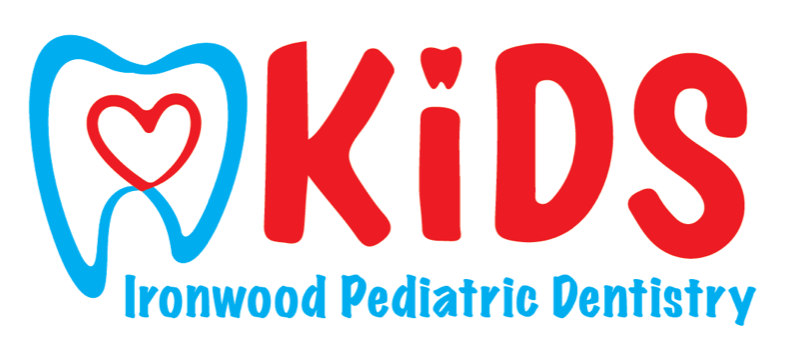The first time your child might notice a stain or a cavity on one or more teeth is when it does not go away after brushing. At this point, you might be wondering if this might be a cavity or tooth decay. How can you tell the difference between tooth staining and tooth decay? And what can you do about either?
Our pediatric dentists at Ironwood Dental have many years of experience treating children’s teeth for cavities and tooth discoloration. If you want to know more about stains and cavities, including how they get started, how to prevent them, and how we can help you treat them, we cover all these and more below.
If you know your child has a problem with teeth staining, tooth decay, or gum disease, call us at (480) 422-4544 to schedule an appointment. Or if you prefer, you can contact us online to communicate with one of our pediatric specialists.
What is a Cavity?
A cavity is the result of the process known as tooth decay. Cavities tend to form on the molars, along the gum line, and in between teeth.
The appearance of a cavity, or visible hole, on the surface of a tooth marks the point where the tooth enamel is permanently damaged. There is no at-home treatment for a cavity.
If you do not have it filled, it will only get worse until the hole in the enamel reaches the dentin layer underneath. This can cause more advanced (and painful) tooth symptoms that need more complex treatment like root canal surgery, dental crowns, or, in the worst case, a tooth extraction.
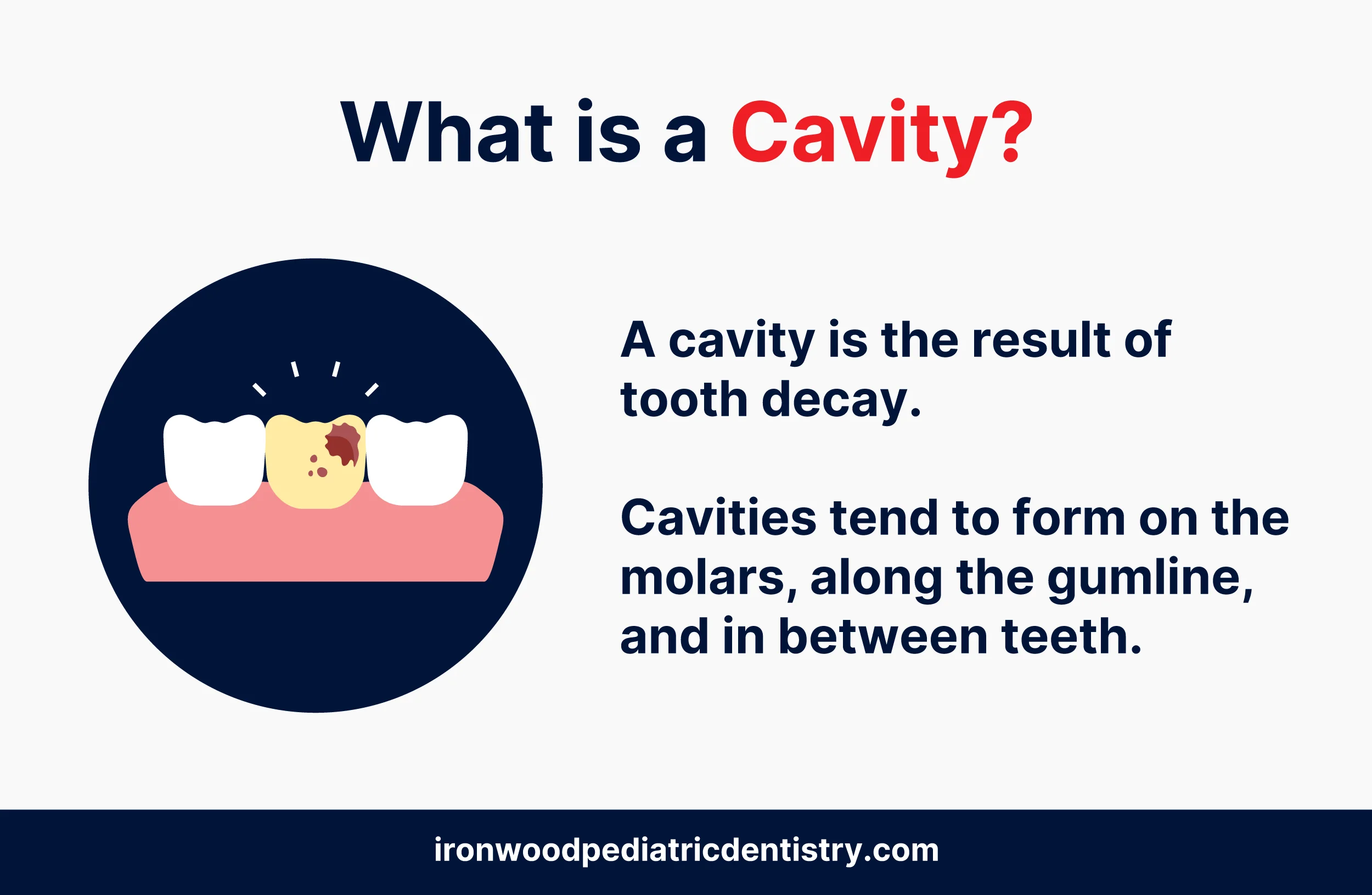
What is a Tooth Stain?
Although a tooth stain and a cavity can appear the same on the surface—as a spot on a tooth—the difference between the two is that unlike a cavity, a tooth stain does not damage tooth enamel.
Tooth surface stains have two main sources. The most common kind is what dentists call extrinsic or external discoloration. This happens when something comes into contact with the tooth surface that stains it.
Another basic cause of tooth staining is intrinsic or internal staining. This is usually caused by damage that happens to the tooth because of trauma to it.
The difference between external and internal tooth staining is that external stains can appear in a variety of colors, while internal staining is gray.
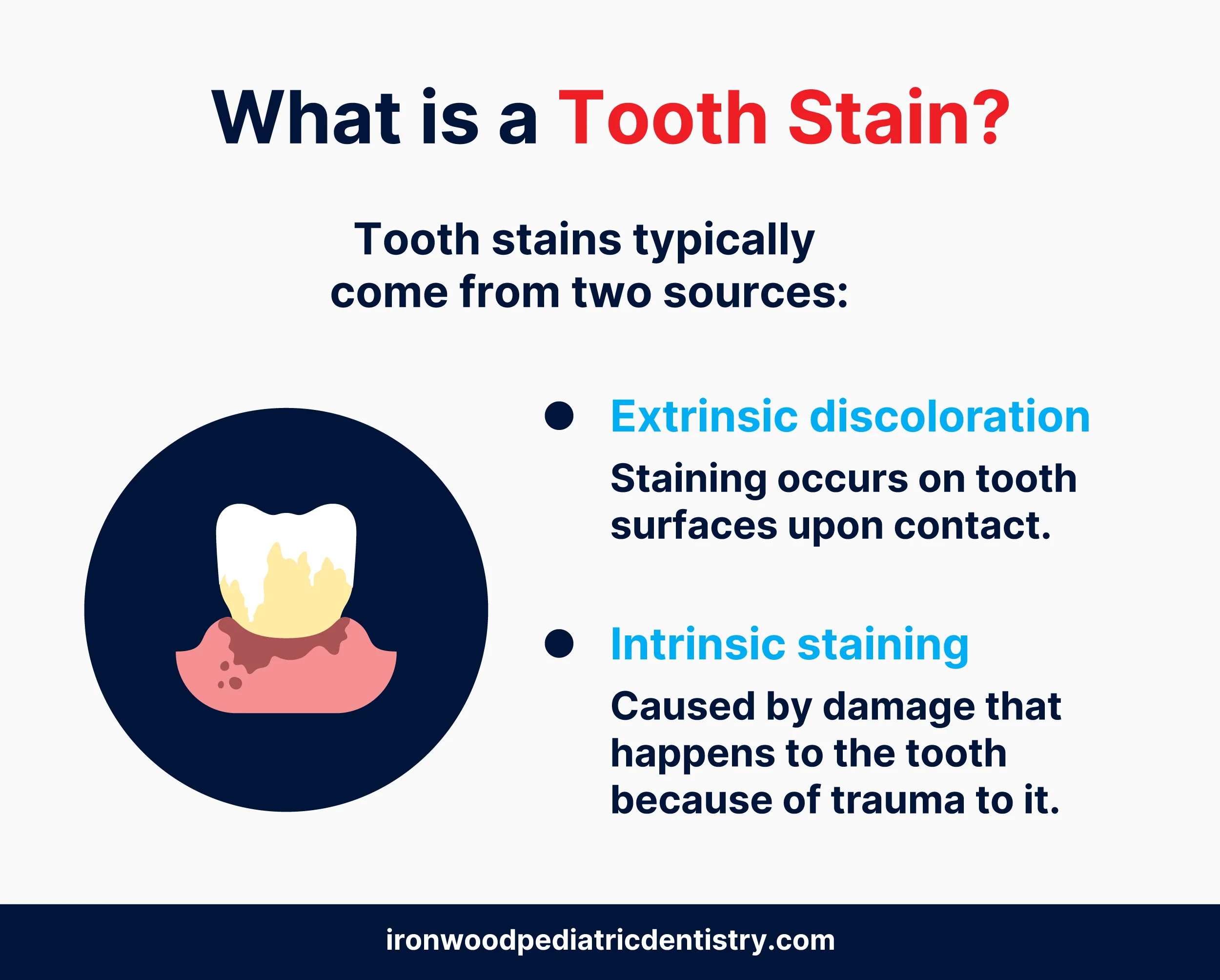
How Can You Tell a Cavity From a Stain?
Tooth stains often have characteristics that tell them apart from cavities if you know what to look for. A cavity is a spot that will gradually darken in color to gray or black but never goes away.
Cavities also tend to slowly spread laterally across the tooth surface because most of the damage is happening below it, so a cavity spot may not seem to change much in size over time.
A tooth stain, on the other hand, can exhibit signs that you will not see in a cavity. These include:
- A stain can cover a larger area of the tooth or the entire tooth. It can span multiple teeth.
- A stain can quickly increase in size, or decrease. In some cases, a stain might even disappear by itself.
- A stain can appear in a rainbow of colors, depending on the source of the stain.
Possibly the most sure-fire way to know if you have a stain or a tooth cavity is to find out if it is painful. Tooth sensitivity is evidence of enamel damage and a cavity. Here are some techniques you can have your child try to see if they trigger a pain response:
- Touch the dark spot on the affected tooth with the tip of the tongue. If no pain results, but your child feels a pit on the tooth surface, this could be evidence of tooth decay that has not punched through the enamel yet.
- Bite into something hard, like a crunchy fruit or vegetable.
- Drink or eat a hot or cold beverage or hot or cold foods.
Another way to know if a spot signifies a cavity is if your child begins to notice a foul taste in the mouth or a foul smell when exhaling through the mouth. These are both evidence of tooth decay.
Causes of Cavities
Cavities form as part of the overall process of tooth decay.
Tooth decay is the result of plaque bacteria in the mouth. These bacteria consume food particles on teeth surfaces and excrete an acid that is harmful to teeth. Left undisturbed long enough, plaque acids will corrode tooth enamel to the point where a visible hole appears. Plaque will eventually harden into tartar along and just underneath the gum line, which leads to gum diseases including gingivitis and periodontal disease.
Factors that contribute to plaque formation, and ultimately cavities, include:
- Acid erosion
- Poor oral hygiene
- Eating sugary foods and drinks
- Chronic dry mouth
- Acid reflux disease
- Fluoride deficiency
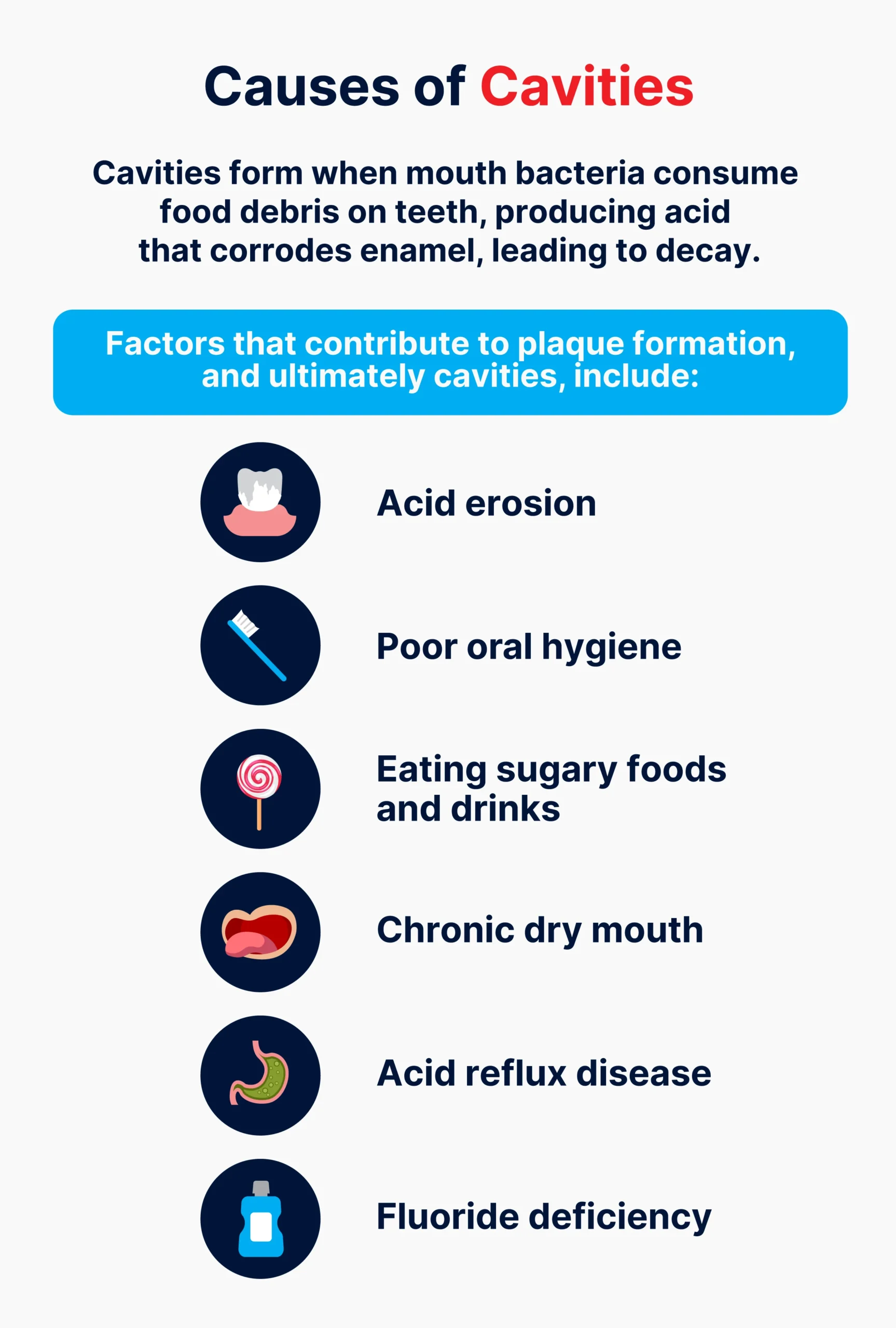
Causes of Teeth Stains
External tooth stains come from many sources. Some of them are easy to guess, others might surprise you. Here are the most common reasons behind stained teeth:
Consuming Foods and Drinks That Stain
Some foods have ingredients that can stain tooth enamel if they are not removed in a timely way. Here are the worst offenders:
- Coffee
- Tea
- Wine
- Soda
- Beets
- Berries
- Chocolate
- Pasta
- Potatoes
- Popsicles
- Candies
- Pickles
- Soy sauce
- Curry
- Tomato sauce
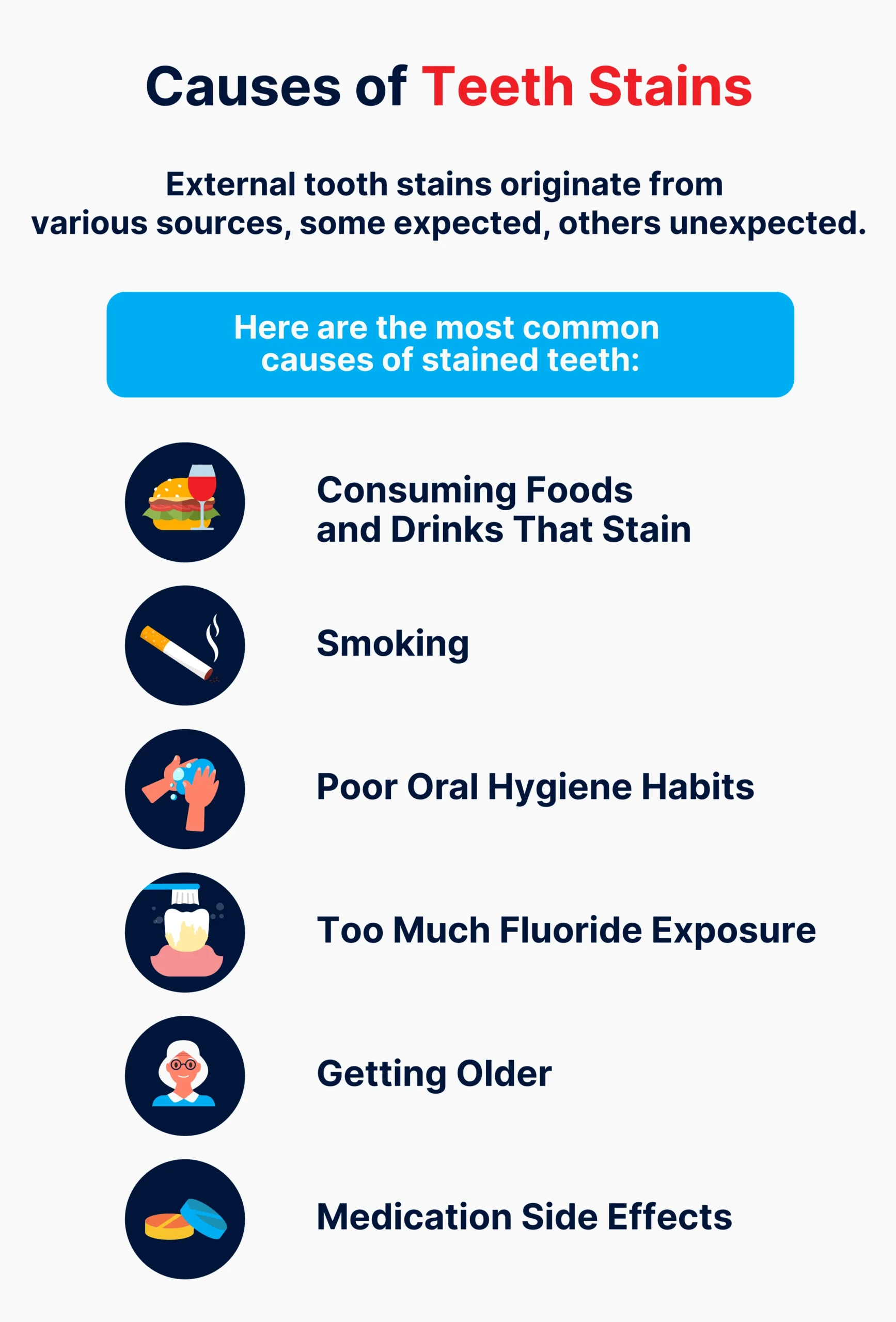
Smoking
Smoking tobacco stains teeth. So does smoking marijuana. Chewing tobacco is another cause of staining. These stains can be harder to remove by brushing and flossing than food stains.
Poor Oral Hygiene Habits
The sooner your child cleans sources of stains from teeth by brushing, flossing, and some other techniques we will cover later, the less likely it is that tooth stains will develop or worsen.
The opposite is true as well. The longer the intervals between brushings, the more time a staining element has to take hold on the enamel surface.
Too Much Fluoride Exposure
Although fluoride can help strengthen developing tooth enamel in children, being exposed to excessive amounts can lead to a condition called fluorosis, which may leave stains depending on the severity.
Getting Older
Although this is not a cause of tooth staining in children, as we enter later adulthood, tooth enamel naturally wears down. As the enamel thins, the yellow dentin underneath can cause the teeth to take on a yellowish look. This is an example of an intrinsic staining condition.
Medication Side Effects
A few kinds of medications, like some antibiotics or medicines to treat hypertension, can cause tooth staining. This is another variation of an intrinsic stain.
Treatment for Cavities
Treatment for cavities is more complex than treatment for tooth stains because treatment is restorative to the tooth structure and not only cosmetic. Parents who want to keep cavity-filling appointments for their children to a minimum can have a meaningful impact on whether their children develop cavities or tooth stains.
Preventive Measures
You do not need to treat cavities if you avoid them. The best way to avoid cavities is to minimize or avoid factors that contribute to tooth decay, like poor dental hygiene. Here are some practical ways to reduce the risk of developing cavities:
- Brushing and flossing. Your child should be brushing and flossing twice daily. Consistent brushing and flossing daily is one of the most effective habits your child can develop, and not only to keep a pearly white smile.
- Use a fluoride toothpaste.
- Use a mouth rinse.
- Limit exposure to sugary and acidic foods and drinks. Sugar is high-octane fuel for the bacteria that cause plaque.
- Schedule regular dental cleanings. This is the best way to support proper oral hygiene at home and to prevent cavities and stains.
- Consider a fluoride sealant treatment. This is a way to protect teeth with a protective fluoride coating that helps tooth enamel to better resist plaque acids.
Cavity Treatment Options
Once a cavity forms, preventive measures like brushing, flossing, and mouth rinses are no longer effective in stopping the cavity from gradually getting worse. Restorative dental treatment by a professional dentist is going to be necessary.
Here are some common ways to fix cavities:
- Fillings: Dental fillings are a common way to treat cavities. Fillings require removing decayed enamel and replacing it with a material that will seal off the cavity site and prevent further damage. Unlike traditional “silver fillings,” modern fillings can be matched to the color of the surrounding teeth, making them hard to see when smiling.
- Crowns: Sometimes tooth decay from a cavity reaches a point where a filling alone will not salvage the tooth. In these cases, we may recommend a dental crown. This procedure removes part of the decayed tooth so that the rest can serve as the foundation of a cap or “crown.” The crown is shaped to match the treated tooth.
- Root canal surgery: In severe cases of tooth decay, the damage penetrates through the enamel and dentin layers and begins to attack the root of the tooth itself. A root canal can save a severely decayed tooth and prevent the need for a tooth extraction.
- Extractions: As a last resort, in cases of tooth decay so advanced that even root canal surgery cannot correct the damage, for health and comfort reasons it may be necessary to remove a tooth. In these cases, replacing the lost tooth with a tooth implant or a dental bridge can help to avoid a tooth gap and maintain the ability to chew food properly.
Treatment for Teeth Stains
Compared to cavity treatments, dealing with teeth stains is simpler, less expensive, and less likely to involve pain or discomfort.
Preventive Measures
Like with tooth cavities, the most efficient, practical, and inexpensive way to remove surface stains is to not let them get started. Many of the same good oral hygiene habits your children can develop to prevent tooth decay are effective in preventing staining, too:
- Cut back on foods and drinks that stain teeth.
- Brush and floss your teeth twice a day.
- Brush soon after consuming meals, snacks, and dark-colored beverages.
- Use a teeth-whitening fluoride toothpaste and mouth rinse (in moderation).
- Drink dark-colored beverages through a straw.
- Do not use tobacco products.
Tooth Stain Cleaning Options
Off-the-shelf whitening solutions are commonly available to reduce tooth stains once they appear. These include whitening strips and at-home whitening trays. These can help reduce or remove minor stains.
If an at-home tooth stain treatment does not remove stains, then it may be time to consider making a tooth cleaning appointment with a dental professional. Our dentists have professional whitening treatments available that over-the-counter products cannot match in restoring your smile to a sparkling white once more.
We offer several choices to whiten teeth at Ironwood Dental. In addition to teeth whitening, in some cases, we may also suggest a dental veneer (a porcelain cap that covers the front of a tooth) or dental bonding.
Talk to a Scottsdale Pediatric Dentist Today
If your child is experiencing tooth pain from a suspected cavity, or is afraid to smile because of stained teeth, then call us today at (480) 422-4544 to schedule an appointment with one of our child-friendly dentists. We treat both cavities and stains.
Prefer to do things online? You can schedule an appointment with us and we will reply to you as soon as possible, usually within 24 hours.
Don’t let tooth stains and cavities stand between your child and the beautiful smile that comes with healthy teeth and gums. Call us today!
